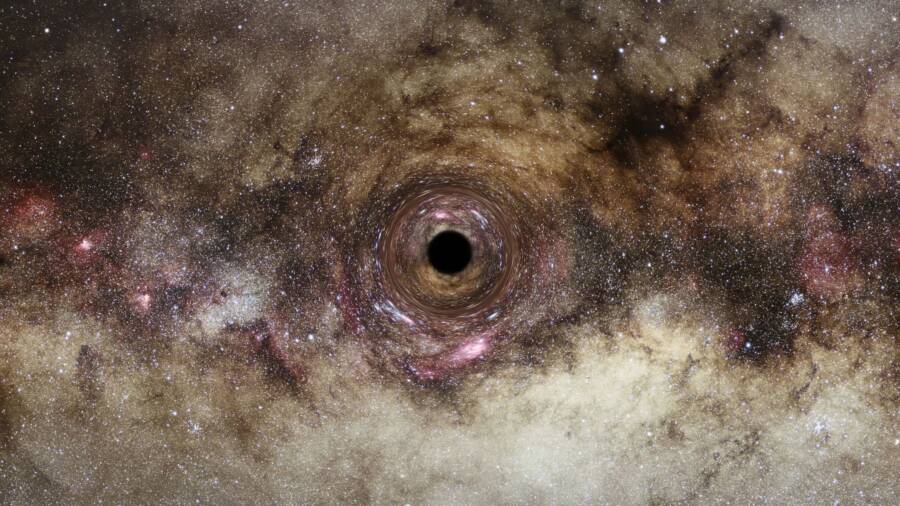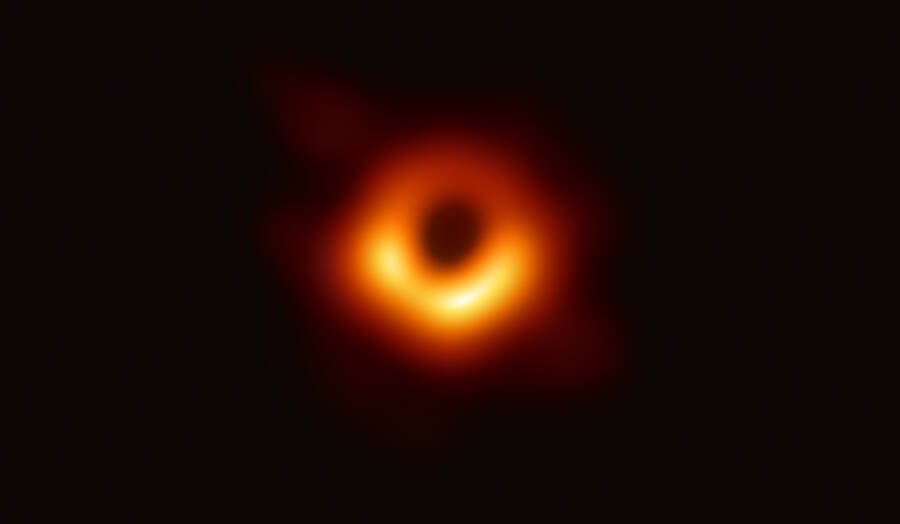Using gravitational lensing, astronomers were able to closely observe the black hole at the center of the Abell 1201 cluster and determine its mind-boggling size.

ESA/Hubble, Digitized Sky Survey, Nick Risinger/skysurvey.org, N. BartmannAn artist’s impression of a black hole, with the massive object’s gravitational pull warping the space around it.
Black holes are the densest objects in the universe, with gravitational pulls so strong that light cannot escape them. Then, there are supermassive black holes, which can be hundreds of thousands of times heavier than their smaller counterparts. But even among these cosmic colossi, there are objects whose mass is so astronomically dense that a new classification is in order: ultramassive black holes.
While the only real distinction between supermassive and ultramassive black holes is their size, the latter is a much rarer sight in the cosmos. Now, astronomers have discovered the existence of a new ultramassive black hole — with a mass over 30 billion times denser than the Sun’s.
And they did it using an optical illusion first predicted by Albert Einstein.
Astronomers noticed that at the center of a cluster over two billion light years away, Abell 1201, an optical illusion known as gravitational lensing was occurring. As they detailed in the study published in the journal Monthly Notices of the Royal Astronomical Society, gravitational lensing occurs when bright light from a background object bends around a foreground object. Viewed from Earth, this makes it seem as if streaks of light are forming a circle around the foreground object.
However, this gravitational lens also functions like a real lens, magnifying the background object and enabling astronomers to examine it in further detail.
“Most of the biggest black holes that we know about are in an active state, where matter pulled in close to the black hole heats up and releases energy in the form of light, X-rays, and other radiation,” said study lead James Nightingale.
“However, gravitational lensing makes it possible to study inactive black holes, something not currently possible in distant galaxies. This approach could let us detect many more black holes beyond our local universe and reveal how these exotic objects evolved further back in cosmic time.”

Event Horizon TelescopeThe first image of a supermassive black hole, located at the galactic core of Messier 87.
As Inverse reported, the concept of gravitational lensing has strong ties to Albert Einstein’s theory of general relativity.
In short, Einstein’s theory of general relativity predicted, among other things, that massive objects have the capability to warp space-time fabrics. Einstein also predicted that these warps in space-time could function similarly to a magnifying lens.
Four years later, in 1919, a group of Einstein’s peers led by Sir Arthur Eddington journeyed to Africa to observe a total solar eclipse and determine whether or not starlight from previously charted stars would, as Einstein predicted, appear to move as a result of the eclipse’s lensing. To their surprise, they did.
Shortly after the trip, Sir Eddington famously performed a short poem about the phenomenon:
“Oh leave the wise our measures to collate
One thing at least is certain, light has weight
One thing is certain and the rest debate
Light rays, when near the sun, do not go straight.”
With Abell 1201, astronomers noticed that gravitational lensing created a duplicate of the cluster’s brightest galaxy, allowing the team to closely examine the black hole at that galaxy’s center. The black hole’s existence had been known prior to the study, but its true size remained unknown.
The team then trained a computer program to analyze the lensed images of Abell 1201 and run a variety of tests to determine possible sizes for the black hole. In the end, simulations determined that a black hole with 30 billion solar masses was the most likely.
“This particular black hole, which is roughly 30 billion times the mass of our Sun, is one of the biggest ever detected and on the upper limit of how large we believe black holes can theoretically become, so it is an extremely exciting discovery,” Nightingale said.
In recent years, scientists have also used gravitational lensing to discover distant galaxies and exoplanets, but this is the first time a black hole has been found using the technique.
Now, astronomers are seeing how gravitational lensing can be used to uncover more black holes, which have historically been difficult to find. Perhaps with time, we may learn more about how these mysterious interstellar objects evolved.
After reading about this fascinating cosmic discovery, check out these 28 James Webb Telescope images that capture the majesty of our universe. Then, learn about recently discovered evidence that suggests black holes may be the source of dark energy.





